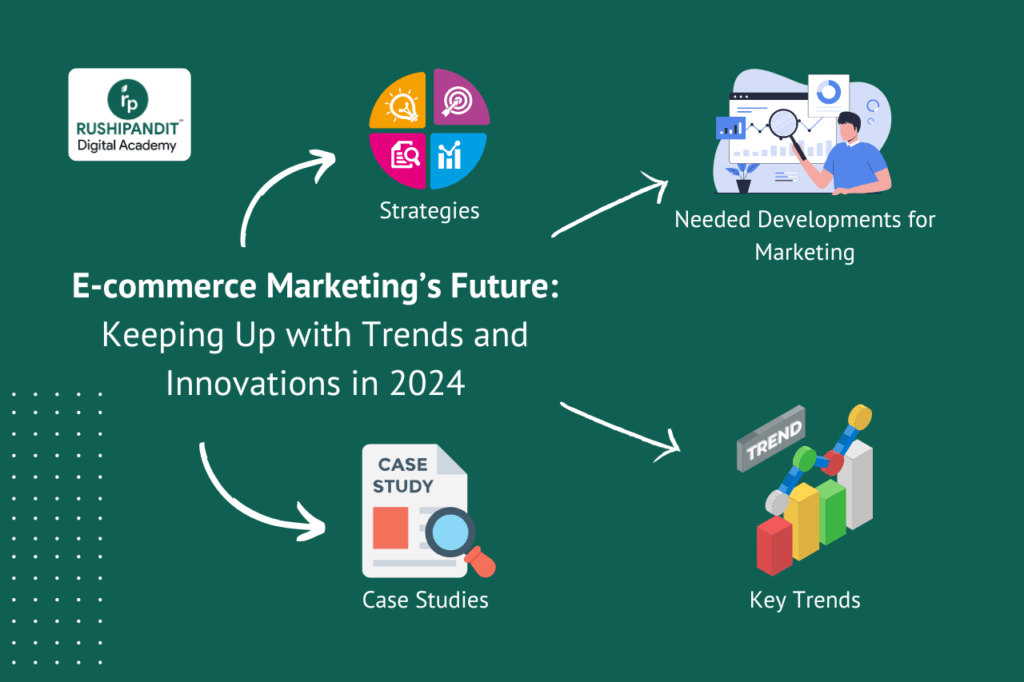Over the past ten years, e-commerce has experienced a seismic change, and the rate of innovation is continuing to accelerate. Looking ahead to 2024, cutting-edge technologies, changing customer behavior, and creative approaches are going to shape the future of e-commerce marketing. An in-depth look at what’s to come and strategies for companies to remain innovative is provided here.
Table of Contents
ToggleThe Development of Marketing for E-Commerce
Simple online stores have given way to intricate ecosystems that provide seamless, personalized, and immersive buying experiences in the realm of e-commerce marketing. A few major forces for this progression are:

1.Technological Advancements:
Technology is crucial to the innovation in e-commerce, ranging from artificial intelligence (AI) and machine learning to virtual reality (VR) and augmented reality.
2.Consumer Expectations:
In order to satisfy the expectations of modern consumers, marketers must develop new tactics that provide quick, easy, and customized purchasing experiences.
3.Data and Analytics:
Businesses can obtain deeper insights into consumer behavior through the use of big data and analytics, resulting in more focused and successful marketing initiatives.
Key Trends Shaping the Future of E-commerce Marketing

1.Personalization and AI:
AI-powered personalization will remain a key area of focus. AI-driven personalization improves the consumer experience by raising engagement and conversion rates through tailored marketing messages and individualized product recommendations.
2.Voice Commerce:
Voice commerce is growing as smart speakers and voice assistants become more commonplace. As more customers use voice commands to search for and purchase products, e-commerce platforms will need to be voice search optimized.
3.Social Commerce:
E-commerce is starting to rely heavily on social media networks. Customers can now make purchases directly within social apps thanks to features like Instagram retail, Facebook Marketplace, and TikTok’s retail integrations, which has made social commerce a substantial source of income.
4.Augmented Reality (AR) and Virtual Reality (VR):
VR and AR technology are revolutionizing the way people purchase online. Customer confidence and pleasure are increased by virtual try-ons, immersive virtual storefronts, and 3D product displays, which assist close the gap between physical and online buying.
5.Sustainability and Ethical Shopping:
Consumers are increasingly conscious of sustainability and ethical practices. Brands that prioritize eco-friendly products, transparent supply chains, and ethical practices will attract a growing segment of conscientious shoppers.
6.Mobile Commerce (M-commerce):
Mobile devices dominate e-commerce traffic. Ensuring that online stores are mobile-optimized, with user-friendly interfaces and fast loading times, is crucial for capturing mobile shoppers.
7.Subscription Models:
Subscription services for products ranging from beauty to groceries are gaining popularity. These models provide businesses with predictable revenue streams and help build customer loyalty.
8.Blockchain and Cryptocurrency:
Blockchain technology promises greater transparency and security in transactions. Cryptocurrency as a payment method is also gaining traction, appealing to a tech-savvy and security-conscious demographic.
Strategies to Thrive in the Future of E-commerce

1.Leverage Data Analytics:
To comprehend consumer behavior, preferences, and trends, use data analytics. This data can be used to better target marketing efforts and enhance the consumer experience.
2.Invest in AI and Machine Learning:
Use artificial intelligence (AI) and machine learning to automate and optimize e-commerce processes, such as inventory management, customer support, and tailored marketing.
3.Enhance Mobile Experience:
Make mobile optimization a top priority to guarantee a flawless online purchasing experience across platforms. Think about creating a mobile application to increase consumer engagement.
4.Adopt AR and VR Technologies:
Incorporate augmented reality and virtual reality into your online business plan to provide customers engaging and dynamic purchasing experiences that set your company apart from rivals.
5.Focus on Social Commerce:
Make use of social media networks for direct sales as well as promotion. Use influencers and shoppable posts to expand your audience.
6.Emphasize Sustainability:
Express your dedication to ethical and sustainable practices. To attract customers who care about the environment, emphasize ecologically friendly products and programs.
7.Optimize for Voice Search:
Make adjustments to your SEO plan to account for voice search optimization. To take advantage of this expanding market, make sure that product descriptions and metadata are voice-search friendly.
8.Explore Blockchain Solutions:
Investigate blockchain solutions for secure, transparent transactions and consider accepting cryptocurrency to attract a broader audience.
Case Studies: Pioneers in E-commerce Marketing

1.Amazon:
As a leader in e-commerce, Amazon continuously innovates with AI-driven recommendations, one-click purchasing, and voice commerce through Alexa. Their focus on customer experience sets the standard for the industry.
2.Warby Parker:
This eyewear company uses AR to allow customers to virtually try on glasses, providing a seamless online shopping experience that closely mimics in-store interactions.
3.Patagonia:
Known for its commitment to sustainability, Patagonia appeals to eco-conscious consumers by emphasizing its environmental initiatives and offering high-quality, durable products.
Conclusion:
E-commerce marketing has a promising and exciting future ahead of it. Businesses may prosper in the rapidly changing digital market by embracing technology breakthroughs, adjusting to shifting consumer behaviors, and placing a premium on sustainability and customization. Remaining adaptable and creative will be essential as we approach 2024 to win over the hearts and wallets of contemporary customers.
Are you prepared to transform your online marketing plan? Put these ideas into practice right now, and you’ll see how e-commerce marketing develops in the future and how your company grows!


